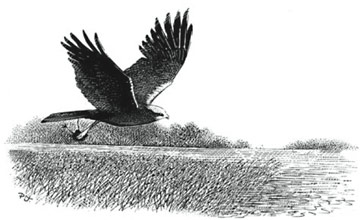
Marsh Harrier © Phil Jones
Marsh Harriers have not yet been known to breed in the county – our First Atlas predicted that ‘future breeding seems unlikely’ – but they are considerably expanding their range and numbers, and occur frequently on spring passage. Several birds have been recorded in suitable breeding habitat, including three during this Atlas. The closest approach to breeding so far appears to have been in 2005 when an adult female was present at a site in the north of the county during June and the first half of July, carrying prey into a marshy area. Close inspection, under a Schedule 1 licence, revealed no nest but a regularly-used food-caching site, with recognisable prey items including Coot, Moorhen and Mallard. No male Marsh Harrier was ever seen.
After coming back from the brink of extinction as a British breeding bird, with only one pair nesting in 1971, their population has grown rapidly. A dedicated national survey in 1995 found a total of 156 breeding females, and the follow-up census in 2005 reported 360 breeding females, an increase of 131%. Females are counted, rather than pairs, because about one-fifth of nests result from polygny, usually one male with two females but occasionally three females sharing one male; such nests are just as successful as those of monogamous pairings (Underhill-Day 1998).
Along with the growth in numbers, Marsh Harriers have extended their distribution. They colonised Leighton Moss in North Lancashire in 1987 and have bred there annually since then, but this is the only regularly-occupied site in western Britain.
Their typical nesting habitat has been extensive Phragmites australis reedbeds, comprising 86% of more than 500 nests recorded during 1983-90 & 1995. All but two of the rest were in cereal crops, mostly oil-seed rape and winter wheat, this habit growing rapidly since it was first recorded in 1982 (Underhill-Day 1998).
Many Marsh Harriers pass through the county in spring and autumn, and it is probably only lack of suitable habitat that restricts the breeding population.
Sponsored by David Kennerley

